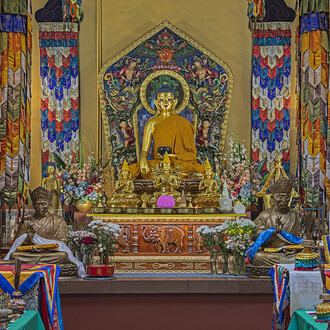On 25 October 2024, the exhibition Peter I and his era began its run at the Hermitage–Siberia Centre in Omsk, timed to mark the centenary of the Omsk Regional Museum of Fine Arts and the fifth anniversary of the centre itself. It tells about Peter the Great’s personality and the main events of his life that to a significant extent determined the fortunes of the Russian state.
Peter’s great accomplishments always began with something small. Out of the youthful tsarevich’s fascination with the sea grew a navy that turned Russia into one of the foremost maritime powers. The paintings, prints, drawings and medals presented in the exhibition allow visitors to see the main events in the history of Peter’s navy through the eyes of its creator – from the famous English sailing boat that the young tsarevich happened upon in Izmailovo to the first Russian ship of the line, the Predestinatsiya, and the rout of the Swedes off Cape Gangut (or Hangö).
The appearance of a mighty fleet in a very short span of time would have been impossible without the development of science and engineering. Although he never received a systematic education, Peter brilliantly mastered not only the occupations of sailor, ship’s captain, pilot, helmsman and navigator, but also those of artilleryman, medical practitioner, land surveyor, astronomer and draughtsman. While perhaps the most well-known occupation of the Tsar and Emperor, in which he achieved the highest mastery, was “the art of turnery”.
Among the items in the exhibition is a copying turning engine from Peter’s collection that was made by his own “personal turner”, Andrei Konstantinovich Nartov. On show alongside are a wood and ivory chandelier and an iron band with a ring, both of which were produced by the Emperor in person during a trip to Olonets in 1724, as well as carved medallions and snuffboxes fashioned in Peter’s turnery.
After the Emperor’s death, his “Turnery” became part of the Academy of Sciences that he also founded. The way that Russia overcame its technological backwardness relative to the European states is told by 18th-century scientific devices and instruments that the Tsar brought back from Holland, Germany, England and France. One memorable exhibit is the summer costume from Peter the Great’s wardrobe that the Tsar may have worn during his second visit to Holland in 1716–17.
The land forces were one more component of the greatness of Peter’s Russia. The prototype for the new army was the “toy” units that the Tsarevich assembled from young nobles around his own age. The fame of the Russian army was forged in numerous battles, the most important of which was the victory at Poltava that determined the outcome of the Northern War. The display includes paintings, prints and bas-reliefs devoted to that encounter and other important actions fought under Peter’s command – both the triumphs (the Battle of Lesnaya, the capture of Azov) and the failures (the first siege of Azov, the clash with the Turks on the River Pruth).
Having entered Peter’s era as a tsardom, Russia emerged from it as an empire. The might of the new state was reflected in its young capital – Saint Petersburg, whose harmonious appearance was determined by Peter himself. This amazing city was built by Russian craftsmen to the designs of European architects, who gave shape to the Tsar’s ideas. Visitors to the exhibition can view many graphic works presenting panoramas, views and plans not only of the capital itself and its suburban estates, but also of individual buildings, some of which never were built or have not survived. Graphic art and costumes cannot be exposed to light for long periods and so the display will be refreshed after four months.
The rapid development of the state was founded upon the results of a sweeping monetary reform that the Tsar began in the late 17th century. Gold and silver coins went into circulation, while hand stamping gave way to the use of machines. In 1724 Peter’s long-cherished dream was realized when an exemplary mint began operating in Saint Petersburg, according with its status as imperial capital. The exhibition features the first silver roubles and copper kopecks from 1704, gold chevontsy and other coins, as well as commemorative medals and decorations produced during Peter’s reign in Moscow and Saint Petersburg.
A particular adornment of the exhibition are the paired portraits of Peter I and his consort and successor Catherine I that were painted by Jean-Marc Nattier and personally approved by the Tsar. Between 2021 and 2023, these works underwent thorough conservation in the State Hermitage’s Laboratory for the Scientific Restoration of Easel Paintings. As a result, exhibition-goers are able to appreciate the depth of the painting, the complexity of shapes and textures, as well as the subtle refinements in the combinations of colours that impressed Peter. The display also includes other pictures from his personal collection, through which we can trace the tastes and enthusiasms of one of the greatest rulers in Russian history.
The curator of the exhibition Peter I and his era is Sergei Alexeyevich Nilov, head of the Winter Palace of Peter the Great Sector in the State Hermitage’s Department of the History of Russian Culture.
















